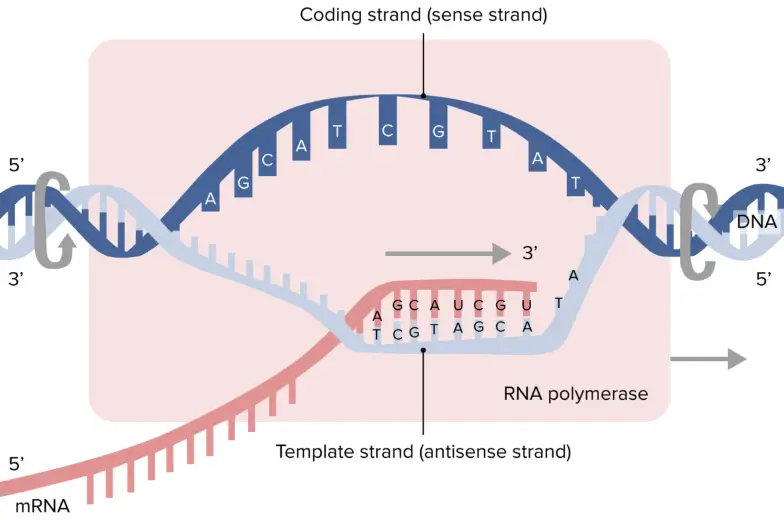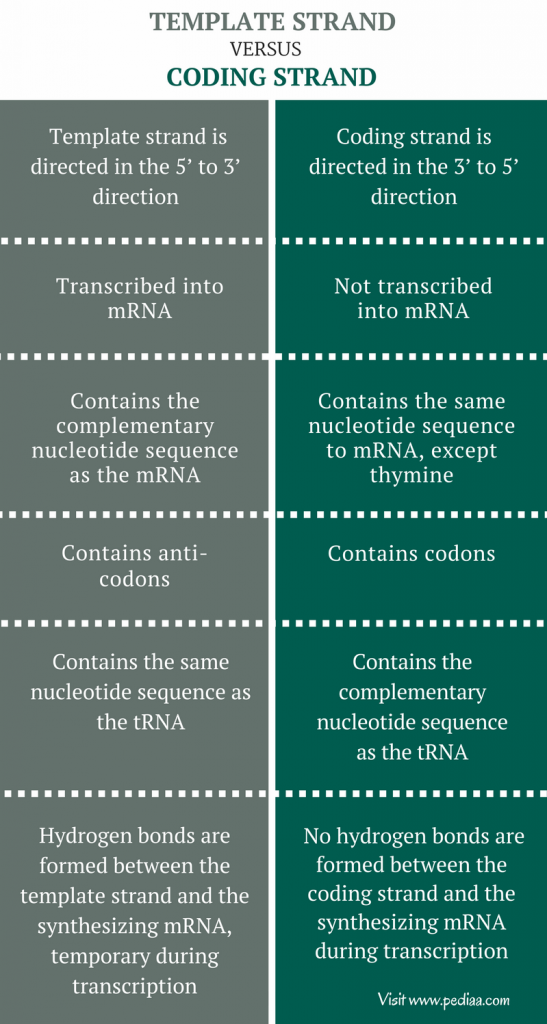Coding And Template Strand - Web the coding strand serves as a template for producing complementary rna. Web differentiate between the sense strand and coding stand. Its counterpart, the antisense strand, guides the. Modified 2 years, 2 months ago. Template strand and coding strand refer to the two complementary strands of dna that encode genetic information. Web active and dynamic, the coding strand is the mirror image of the template strand. Web the coding strand and template strand are two complementary strands of dna that play different roles in the process of transcription. The two distinct strands of double. Web the coding strand provides a reference for the formation of mrna with a similar sequence, while the template strand guides the rna polymerase to synthesize a. Web is it possible to distinguish between coding and template strands from the sequence?

Information Flow and Levels of Regulation Medical 1st Ed
Web the coding strand of each dsrna has a single orf, except for seg11 and seg12 of rdv (table 28 ), seg9 of rice gall dwarf virus (rgdv) and seg9 of wtv. The term template strand refers to the dna sequence that can duplicate itself. Web is it possible to distinguish between coding and template strands from the sequence? Web.

Coding NonCoding Sense Antisense Template and NonTemplate Strands
When referring to dna transcription, the coding strand (or informational strand ) is the dna strand whose base sequence is identical to the base sequence of the rna transcript produced (although with thymine replaced by uracil). Web the difference between a template and a coding strand is primarily based on two characteristics: The term template strand refers to the dna.

Template Strand Vs Coding Strand Understanding The Difference GRAPHICOLD
Web active and dynamic, the coding strand is the mirror image of the template strand. The two distinct strands of double. Web the coding strand turns gray and then disappears, leaving the template strand (see strands above ). Web the coding strand serves as a template for producing complementary rna. The other strand, the coding strand, is identical to the.

Template and coding strand targeting of spacers. A Schematic
The term template strand refers to the dna sequence that can duplicate itself. Web the template strand is the one that rna polymerase uses as the basis to build the rna. Web get ready for a journey into the intricacies of dna’s coding and template strands as we unlock the secrets of genetic information transfer and protein production. Web differentiate.

DNA Transcription Steps and Mechanism • Microbe Online
Web the coding strand turns gray and then disappears, leaving the template strand (see strands above ). Differentiate template strand and antisense strand ? Web differentiate between the sense strand and coding stand. Also known as the sense strand, it carries the genetic code for protein synthesis. Web the coding strand of each dsrna has a single orf, except for.

Coding Versus Template Strand
The other strand, the coding strand, is identical to the rna transcript in sequence, except that it has uracil (u) bases in place of thymine (t) bases. Differentiate template strand and antisense strand ? The two distinct strands of double. Web is it possible to distinguish between coding and template strands from the sequence? Web get ready for a journey.

Difference Between Template and Coding Strand Compare the Difference
The other strand, the coding strand, is identical to the rna transcript in sequence, except that it has uracil (u) bases in place of thymine (t) bases. Web active and dynamic, the coding strand is the mirror image of the template strand. It serves as the direct template for rna synthesis during transcription. The coding strand is the strand of.

Difference between Sense Strand and Antisense Strand of DNA Dna
Web the coding strand provides a reference for the formation of mrna with a similar sequence, while the template strand guides the rna polymerase to synthesize a. Asked 3 years, 9 months ago. In transcription, a region of dna opens up. It serves as the direct template for rna synthesis during transcription. Web the coding strand turns gray and then.

Difference Between Template and Coding Strand
Modified 2 years, 2 months ago. Web the coding strand serves as a template for producing complementary rna. Template strand and coding strand refer to the two complementary strands of dna that encode genetic information. When referring to dna transcription, the coding strand (or informational strand ) is the dna strand whose base sequence is identical to the base sequence.

PPT Chapter 11 Transcription PowerPoint Presentation, free download
One strand, the template strand, serves as a template for synthesis of a complementary rna transcript. Web the coding strand of each dsrna has a single orf, except for seg11 and seg12 of rdv (table 28 ), seg9 of rice gall dwarf virus (rgdv) and seg9 of wtv. Web the template strand is the one that rna polymerase uses as.
Web the coding strand of each dsrna has a single orf, except for seg11 and seg12 of rdv (table 28 ), seg9 of rice gall dwarf virus (rgdv) and seg9 of wtv. Web active and dynamic, the coding strand is the mirror image of the template strand. Web the difference between a template and a coding strand is primarily based on two characteristics: Differentiate template strand and antisense strand ? Web the coding strand provides a reference for the formation of mrna with a similar sequence, while the template strand guides the rna polymerase to synthesize a. Template strand and coding strand refer to the two complementary strands of dna that encode genetic information. When referring to dna transcription, the coding strand (or informational strand ) is the dna strand whose base sequence is identical to the base sequence of the rna transcript produced (although with thymine replaced by uracil). The other strand, the coding strand, is identical to the rna transcript in sequence, except that it has uracil (u) bases in place of thymine (t) bases. Web get ready for a journey into the intricacies of dna’s coding and template strands as we unlock the secrets of genetic information transfer and protein production. One strand, the template strand, serves as a template for synthesis of a complementary rna transcript. Human anatomy & physiology (11th edition) 11th edition. Asked 3 years, 9 months ago. Web the coding strand and template strand are two complementary strands of dna that play different roles in the process of transcription. In transcription, a region of dna opens up. Its counterpart, the antisense strand, guides the. Web the coding strand serves as a template for the rna polymerase, which ensures that the rna strand is complementary to the coding strand. Web the coding strand serves as a template for producing complementary rna. Web the template strand, as its name suggests, is used as a template during transcription to synthesize the rna molecule with a complementary sequence to the. Web differentiate between the sense strand and coding stand. The two distinct strands of double.